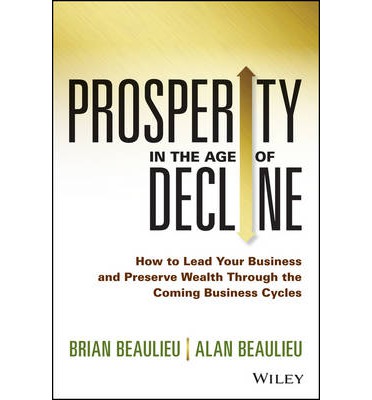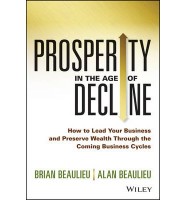Authors: Brain Beaulieu and Alan Beaulieu
Publisher: Wiley – 232 pages
Book Review by: Sonu Chandiram
The authors of this wonderful book cite a lot of economic statistics (which is a positive in establishing their case) in its 15 chapters and declare that another Great Depression is inevitable.
They take into account such factors as low interest rates that have wiped away income for seniors; the unsustainable level of U.S. government debt that could lead to higher taxes and / or runaway inflation or both, caused by massive currency printing; and an aging population that constantly increases burdens (e.g. healthcare costs) on younger people.
The Beaulieus suggest ways – in this insightful book with well-researched data that support their recommendations – that can help you protect your assets from eroding in value, make your business and finances flourish through upcoming economic cycles, and benefit handsomely, as we make our way coming out of the next Great Depression.
They point out to the unmistakable trends in our economy which we can take advantage of by positioning ourselves correctly to make a lot of money, as well as threats to our economic security that we must protect ourselves against.
That the United States is in economic decline cannot be denied, with some of the government and national numbers we cite below. But how is your personal economy and what can you do to improve it? This book has many of the answers for you, as you take stock of your assets and liabilities, and make a list of tasks to enhance your financial situation.
Let us consider figures relating to the balance sheet and income of our government. These are core measures of prosperity: our economic well being, or lack of it.
The balance sheet is terrible and continues to worsen day by day. Since Barack Obama was sworn into office as U.S. president on January 20, 2009, the debt of the United States government, according to the U.S. Bureau of the Public Debt, has exploded by almost $7 trillion, or more than 65 percent ($17.604 trillion on July 15, 2014 compared to $10.627 trillion on Jan 20, 2009, a difference of $6.977 trillion – go to http://treasurydirect.gov/NP/debt/current).
Why Obama has deficit-spent an average of $1.268 trillion a year ($6.977 trillion total addition to debt divided roughly by his 5.5 years at the White House) which is way, way over the government’s annual revenues, shocks most everyone. The annual deficit-spending amounts to nearly $3.5 billion overspent each day. And Obama has absolutely no debt repayment plan. Is he going to come to you the taxpayer and say: “hey, you’ve got to pay even more in taxes”?
Mind you, this is not just spending. It is money being spent that the government does not have, and must borrow from the public, since raising higher taxes to make up the difference is politically suicidal for Obama and other Democrats. And if the government cannot borrow more, as has happened when it has not been able to sell debt – bonds, bills, and notes – it simply makes money out of thin air by printing it (or electronic creation, as has happened sometimes). Such money-creation has decreased the value of the money you hold.
Why the chief executive of our country has willfully burdened the U.S. government with trillions more of debt, and relentlessly continues to do so, baffles most people. But one of the most insightful reasons cited for such reckless deficit-spending and massive addition to debt is revealed in the book Obama’s America.
In it, the author Dinesh D’Souza states that Barack Obama does not want the United States to continue to be No.1 in the world. Shocking as it seems, but we have found no other logical explanation, and all the excuses given by Obama such as blaming former President George W. Bush, Europe’s recession, etc., hold no validity in fact.
But what is much worse is the total of unfunded liabilities of the U.S. government, which was $127 trillion about six months ago (and continues to balloon) as mentioned in a January 17 Forbes article by Vance Ginn. The unfunded liabilities number is the difference between the net present value of expected future government spending and the net present value of projected future tax revenue.
In terms of the growth of our collective national income, the picture is not pretty either. The U.S. gross domestic product – a broad measure of the economy was -4.10 percent in the first quarter of 2009, meaning it shrunk by that amount. It was also -2.9 percent in the first quarter of 2014 also, or another contraction.
In between those periods, the U.S. economy has been limping along at a weak average annual growth of less than two percent from 2009 to the present. But when you take into account the government’s own estimated average annual inflation rate of two percent (which has been cited by many independent economists as invalid and too low) in the same period, we had no real economic growth in the last five-plus years. In other words we’ve had stagnation.
The official U.S. unemployment rates announced by the U.S. Bureau of Labor Statistics once a month over the years are also not real and actual measures because the corporate and household surveys they are based upon do not count millions of unemployed in numerous sectors of the economy.
But let’s face it: there is almost nothing that you and I can do to change the way Obama has incompetently managed the nation’s finances with reckless and irresponsible deficit-spending and growing the government’s future obligations to its employees and military personnel.
This book however, can give you the important tools to equip you to handle your own finances so you can prosper in the present (and coming) age of U.S. decline. You can reduce your company’s or your own debt; get into the businesses that will thrive in the coming years; or sell product lines and / or services that will be in greater demand, yielding larger profits to you.








